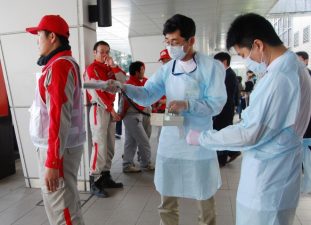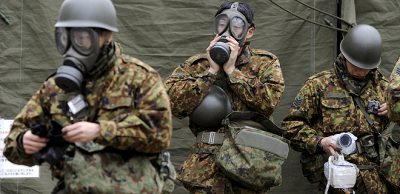 Located in the southern province of Mersin, on the Mediterranean Sea, the Akkuyu nuclear plant has been controversial since it was first proposed in the 1970s.
Located in the southern province of Mersin, on the Mediterranean Sea, the Akkuyu nuclear plant has been controversial since it was first proposed in the 1970s.
The meltdown at the Japanese Fukushima nuclear plant last year didn’t stall Turkey’s plans to build its own nuclear reactors. Like many Middle Eastern countries, as Green Prophet reported, Turkey announced its intent to continue full-speed with its nuclear power program. Now, 3D images of the country’s first planned nuclear facility have been released — and despite some greenwashing, they don’t look pretty.
What’s planned
The $20 billion plant will be built and majority owned and operated by Russian atomic energy agency ROSATOM. To give it more of a “Turkish theme”, however, the general manager of the project company says the roof of the structure enclosing the reactors will be topped by a “Turkish style dome”.
Akkuyu will have a final generating capacity of 4,800 MW, or nearly one-tenth of Turkey’s total installed power generating capacity. There will be no noise pollution or waste seepage, and employees “will not have to wear any special gear” once the plant is up and running.
The plant will “have the look of a scientific research institute,” according to Turkish Hurriyet Daily News, the paper that released the 3D images. It will be the size of two football fields, and located on the coast of the Mediterranean Sea, whose waters it will draw from for cooling purposes.
Construction is expected to begin in 2013.
Location, location, location
Sounds pretty good so far, but the devil’s in the details. Here are the major flaws you won’t read about in the Daily News article:
– The plant is slated to be built 16 miles from an active fault line. (This piece of information caused one of the original scientists who signed off on Akkuyu’s first license in 1976 to revoke his support for the project.)
– The Akkuyu facility will supposedly be designed to withstand an earthquake rated 9.0 on the Richter scale. But the type of nuclear plant that ROSATOM is building, the VVER 1200, has never been built before — meaning its design has never been tested by an actual earthquake.
– Because of the plant’s proximity to the Mediterranean Sea, no cooling towers will be built. The plan is to use Mediterranean water as a coolant and then “redirect the water back to the sea completely uncontaminated.” But the Mediterranean Sea can reach temperatures up to 30 degrees Celsius (86 degrees Fahrenheit) in the summer, meaning it will be too hot to adequately cool the reactors.
– Furthermore, the water that is returned to the sea will be much hotter than when it was retrieved, giving it the potential to seriously damage marine life in the area.
– There is no visible plan for how Akkuyu will dispose of the nuclear waste generated by the facility. The plan insists that “no radiation will be released in any form outside of the boundaries of the plant,” as though it will simply evaporate away.
– Finally, the entire project has been pitched to the Turkish public as a way for Turkey to wean itself off dependence on foreign energy imports. But a Russian state-owned company will majority own and operate the facility. That doesn’t seem very energy-independent.
Turkey hoping to have three nuclear plants in a decade
ROSATOM is looking to take over the other two nuclear plants Turkey hopes to build in the next decade, according to the article in Hurriyet.
A Korean company that had been interested in one of those projects announced that it expected Turkey to cancel its nuclear plans after the massive earthquake that rocked the country’s southeast last October, but Turkey’s government is obviously not fazed by the prospect of similar destruction occurring within a nuclear zone.
Of all countries in the Middle East, Turkey should be most aware of the risks of nuclear power: the Chernobyl nuclear meltdown in 1986 occurred just across the Black Sea from Turkey’s northern coast, ruining two seasons of crops and causing untold disease in residents.
The fact that Turkey’s government is pursuing a nuclear project as flawed and short-sighted as Akkuyu does not bode well for the future of nuclear development in the country. Turkey’s public seems aware of this — huge public protests against the plant have been taking place for the past three decades. Hopefully, the government will eventually pay attention to what its own populace is saying.
Read more about nuclear power in Turkey:
Turkey Expected To Cancel Nuclear Plans After Massive Earthquake
Post-Chernobyl Agriculture In Turkey: A Sign Of What’s In Store For Japan?
Despite Japan, Turkey Goes Ahead With Nuclear Reactors
Image via Hurriyet Daily News



You have written “Turkey hoping to have three nuclear plants in a decade”. But this needs correction. Only goverment wants nuclear plants, people not. After Chernobyl nuclear meltdown, the deaths caused by cancer skyrocketed. I live in Giresun (a small Black Sea region city)and lost my 3 family member from cancer. Akkuyu is far away from Giresun but nobody in Giresun support Akkuyu nuclear plant.
This article suggests that “the [nuclear] waste will be dumped into the Mediterranean.”
This is absurd. The Russians have a complete cradle-to-grave nuclear fuel approach that will include transport of the spent nuclear fuel back to Russia, where it will be stores and eventually reprocessed (to recovery the 95% of useable nuclear fuel remaining after use).
International treaties DO NOT allow dumping of nuclear waste or spent nuclear fuel into the sea and this is not done today by anyone. Saying that the Akkuyu plant would do so shows that the writer is either ignorant or is blatantly trying to stir up public fear.
Fact check, please!